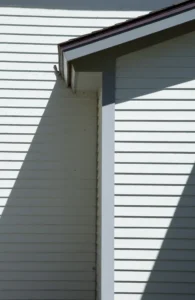Are you tired of the worn-out, outdated siding on your home? Want to give your home a fresh new look? You’re not the only one! A replacement siding project is extremely popular amongst homeowners in Maryland and Virginia thanks to not only its aesthetic appeal but structural benefits too. But, let’s face it, the cost of siding replacement can be daunting. Don’t fret just yet, though. In this article, I’m going to share with you the top 5 cost factors that contribute to siding expenses. By arming yourself with this knowledge, you’ll be better equipped to make informed decisions and budget wisely for your siding home improvement project.
How Much Does Siding Cost in Virginia and Maryland?
So, how much can you expect to pay for new siding if you live in Maryland or Virginia? Well, it can vary widely depending on several factors. Material quality, labor costs, preparation and clean-up costs, permits and regulations, and customization and design are all important factors that can impact the overall cost of your siding replacement project.
On average, homeowners in Virginia and Maryland can expect to spend between $6,000 and $16,000 for a full siding replacement project, with the cost per square foot ranging from $3 to $10. However, it’s important to note that these are just rough estimates and that the actual cost of your project may be higher or lower depending on your specific needs and circumstances.
Alright, let’s dive into the specifics of siding costs and the top five cost factors you need to consider.
1. Material Quality
When it comes to siding replacement, the quality of the material you choose can significantly impact the overall cost of your project. Higher-end materials like fiber cement, natural stone, or cedar can cost more than traditional vinyl siding options, but they offer superior durability, longevity, and aesthetic appeal.
Choosing high-quality siding materials can be more expensive upfront, but it offers long-term benefits that make it a worthwhile investment. For example, fiber cement siding is more durable and weather-resistant than vinyl siding, which means it can last up to 50 years with proper maintenance. Natural stone siding offers exceptional durability and a unique, upscale appearance that can increase your home’s value. Cedar siding is known for its natural beauty, excellent insulation properties, and resistance to decay and insect infestation.
While these materials may cost more, they can save you money in the long run. Investing in high-quality siding materials means that you won’t have to replace your siding as frequently, which can save you money on repair costs and reduce the frequency of home improvement projects. In addition, high-end materials can increase your home’s energy efficiency, which can lead to lower energy bills over time.
Here’s a quick overview of the most popular types of siding and their benefits:
- Vinyl Siding: Cost-effective, variety of colors and styles, lifetime warranty, easy to clean, and resistant to insect damage and rot.
- Wood Siding: Eco-friendly, easier to install, can be painted or stained to any color.
- Cement Fiber Siding: Highly durable, can be shaped into various textures and styles, has good energy efficiency, is resistant to water and insects, and is non-flammable.
- Foam-Backed Vinyl Siding: Excellent energy efficiency, easily cleaned, reduces noise, comes in different colors and designs, and is not susceptible to moisture and insect damage.
Ultimately, choosing high-quality siding materials is an investment in your home’s longevity, aesthetic appeal, and value. Don’t be afraid to weigh the cost versus the benefits when making your decision, as investing in superior materials can pay off in the long run.
2. Labor Costs
Labor costs are an unavoidable part of a siding project, especially if you want the job done right. Several factors can impact the cost of labor, including the size of your home, the complexity of the installation, and regional labor rates. For example, if you have a large home, it will take more time and effort to complete the installation, which will increase the labor costs. Similarly, if your siding installation requires intricate design or requires unique preparation, such as addressing underlying structural issues, it will likely increase the labor costs.
It’s important to note that quality workmanship is crucial when it comes to siding replacement. Hiring a professional, experienced contractor who understands the nuances of siding installation can ensure that the job is done correctly, which can save you money in the long run by avoiding costly repairs or re-installation. Don’t skimp on the quality of labor to save costs, as this can result in shoddy work and subpar results
3. Preparation and Clean-Up
In addition to material and labor costs, there are also additional costs associated with preparing for and cleaning up after the siding installation. Preparation costs refer to any work that needs to be done before the new siding can be installed. This can include removing existing siding, repairing or replacing damaged areas, and addressing underlying structural issues. Clean-up costs refer to the cost of cleaning up the job site once the installation is complete.
Proper preparation and clean-up are critical for a successful siding replacement project. Skipping these steps or cutting corners can result in subpar results, damage to your home, or additional costs down the line. It’s essential to work with a reputable contractor who understands the importance of proper preparation and clean-up and includes these costs in their estimate.
4. Permits & Regulations
When it comes to siding replacement in Maryland and Virginia, it’s important to understand that there may be additional costs associated with permits and regulations. Permit and regulation costs refer to the fees associated with obtaining the necessary permits and complying with local regulations and building codes.
Local regulations and building codes can impact the cost of your siding replacement project by requiring specific materials, design elements, or installation methods. For example, in some areas, you may be required to use specific materials that meet local fire codes or energy efficiency standards. Additionally, obtaining the necessary permits can be time-consuming and costly, which can add to the overall cost of your project.
It’s crucial to comply with local regulations and building codes to ensure the safety and quality of your home’s siding replacement project. Non-compliance can result in additional fees, fines, or even legal action. Working with a reputable contractor who understands the local regulations and building codes can help you navigate the process and avoid any unnecessary costs or complications.
5. Customisation & Design
Finally, let’s talk about customization and design. Customization and design costs refer to the additional expenses associated with adding unique features or custom elements to your siding replacement project. These costs can vary widely depending on the scope of the customization and the materials used.
Customization can significantly impact the overall cost of your siding replacement project, but it can also enhance the aesthetic and value of your home. Customization options may include decorative trim, unique color palettes, or intricate patterns. However, it’s important to carefully consider your customization options and ensure that they fit within your budget and align with your overall design goals.
Working with a skilled contractor who understands design principles and can provide guidance on customization options can help you make informed decisions about your project. A contractor who values open communication and collaboration can help you strike a balance between cost and design, ensuring that you achieve the look and feel you want while staying within your budget.
Why It’s Worth Paying More for Quality Siding
When it comes to siding, it’s easy to focus solely on the cost. But the truth is, investing in quality siding is worth the extra expense. Siding not only adds aesthetic value to your home, but it also acts as a protective barrier against the elements, ensuring the longevity of your home’s interior structure. That’s why it’s important to choose a reputable and reliable contractor who prioritizes quality workmanship.
Transform Your Home with a Top-Quality Siding Replacement Project
Don’t let the cost of a siding replacement project deter you from achieving the look and feel you want for your home. With our help, you can achieve a beautiful and functional siding replacement project that fits within your budget and exceeds your expectations. Contact us today for a free, no-obligation quote and take the first step towards transforming your home with new siding.



